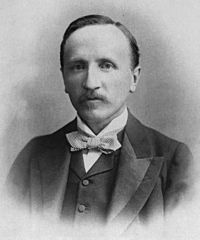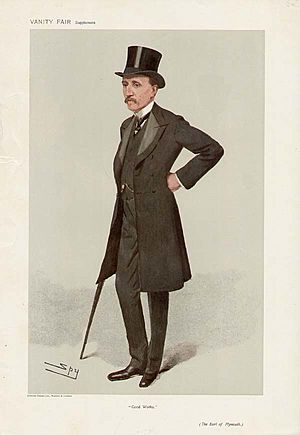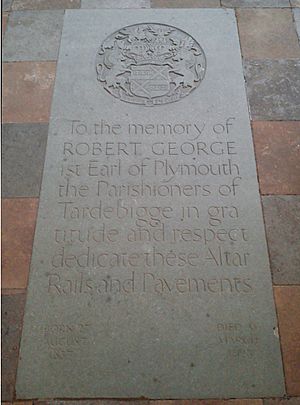Robert Windsor-Clive, 1st Earl of Plymouth facts for kids
Quick facts for kids
The Earl of Plymouth
|
|
|---|---|
 |
|
| Paymaster General | |
| In office December 1890 – 11 August 1892 |
|
| Monarch | Queen Victoria |
| Prime Minister | The Marquess of Salisbury |
| Preceded by | The Earl of Jersey |
| Succeeded by | Charles Seale-Hayne |
| First Commissioner of Works | |
| In office 11 August 1902 – 4 December 1905 |
|
| Monarch | Edward VII |
| Prime Minister | Arthur Balfour |
| Preceded by | Aretas Akers-Douglas |
| Succeeded by | Lewis Harcourt |
| Personal details | |
| Born | 27 August 1857 |
| Died | 6 March 1923 (aged 65) |
| Nationality | British |
| Political party | Conservative |
| Spouse | Alberta Paget (1863–1944) |
Robert George Windsor-Clive, 1st Earl of Plymouth (born August 27, 1857 – died March 6, 1923), was an important British politician. He was a member of the Conservative Party. Before becoming an Earl, he was known as the 14th Baron Windsor from 1869 to 1905. He also helped start the London Society, which works to improve London.
Contents
Early Life and Education
Robert George Windsor-Clive was born in London. His father was Robert Windsor-Clive, and his mother was Lady Mary Selina Louisa Bridgeman. His grandmother, Harriett, was the 13th Baroness Windsor.
When he was 12 years old, in 1869, he inherited the title of Baron Windsor from his grandmother. He went to a famous school called Eton College. Later, he studied at St John's College, Cambridge. He earned his first degree in 1878 and a master's degree in 1891. Cambridge University also gave him an honorary law degree in 1900.
Homes and Estates
As Lord Windsor, he owned a large amount of land. He asked famous architects to build a new country house called Hewell Grange. This grand house was finished between 1884 and 1891. His family had owned the land at Hewell Grange since the 1500s. You can still see old ruins and many historic buildings there today.
The Windsor-Clive family also had another home, St Fagans Castle, near Cardiff in Wales. They often stayed there in the summer. This 16th-century house is now part of the National Museum of Wales. It is set up to look just as it did when the family lived there.
Political Career and Public Service
Robert Windsor-Clive had a busy career in politics. He worked for the government in several important roles.
Working for the Government
From 1890 to 1892, he served as Paymaster General. This role involved managing government payments. In 1891, he became a member of the Privy Council, a group of advisors to the King or Queen.
Later, from 1902 to 1905, he was the First Commissioner of Works. This meant he was in charge of government buildings and public spaces. During this time, he helped turn The Mall in London into a grand road for parades. He also approved the plans for the Queen Victoria Memorial outside Buckingham Palace.
Becoming the Earl of Plymouth
In 1905, a special honor was given to him. The title of Earl of Plymouth was brought back for him. This title had not been used since 1843. He became the Viscount Windsor and the Earl of Plymouth.
Local and National Contributions
Besides his work in the national government, he was also the Mayor of Cardiff from 1895 to 1896. During his time as Mayor, he welcomed the Prince and Princess of Wales (who would later become King Edward VII and Queen Alexandra) and their daughters to Cardiff.
He received several important awards for his service. He became a Companion of the Order of the Bath in 1905. In 1918, he was made a Knight Grand Cross of the Order of the British Empire. He also received an award from France, the Officer of the French Legion of Honour. He was once the leader of the Union of Conservative Associations.
Other Important Roles
Lord Plymouth held many other public positions throughout his life.
Military Service
He was involved in the military, serving in the Worcestershire Yeomanry. He started as a Second Lieutenant in 1878 and rose to Lieutenant-Colonel. He also held honorary colonel positions in several other military units.
Cultural and Charitable Work
Lord Plymouth was a Sub-Prior of the Order of St John of Jerusalem, a charitable order. In 1900, he became a Trustee of the National Gallery, an important art museum. He was also the first President of The Concrete Institute, which is now called the Institution of Structural Engineers.
In 1913, he played a key role in buying The Crystal Palace for the nation. This famous building was originally built for the Great Exhibition of 1851. He also served twice as President of the Cambrian Archaeological Society, which studies history and archaeology in Wales.
Community Leadership
In 1913, Lord Plymouth welcomed the Duke and Duchess of Argyll to his home, Hewell Grange. The Duchess was Princess Louise, the sister of King Edward VII. He joined them in Birmingham to open a new hospital and unveil a statue of King Edward VII. In 1918, he became the first President of The Birmingham Civic Society, which works to improve the city.
From 1914 until his death in 1923, Lord Plymouth was the chairman of the National Trust. This organization works to protect historic places and natural beauty in England, Wales, and Northern Ireland.
Family Life
In 1883, Lord Plymouth married Alberta Victoria Sarah Caroline Paget. They had three sons and one daughter. Sadly, his eldest son, Other Robert Windsor-Clive, died before him in 1908. His third son, Lieutenant Archer Windsor-Clive, was a soldier who died in battle in 1914 during World War I.
Lord Plymouth passed away suddenly in March 1923, at the age of 65. He was buried in Tardebigge, Worcestershire. His second son, Ivor, inherited his title. The Countess of Plymouth died in 1944 and was buried next to her husband and their son.




